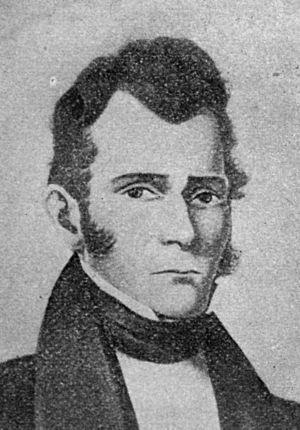Indiana Rangers facts for kids
Quick facts for kids Indiana Rangers |
|
|---|---|
| Active | 1807–1809 1811 1812–1815 |
| Country | |
| Allegiance | Indiana Territory |
| Branch | Indiana Territorial Militia |
| Type | Infantry (1807–1809, 1811, 1812–1815) Dragoons (1812–1815) |
| Role | Protect Indiana Territory from Indian attacks |
| Size | 3 divisions (1807–1809): 1st Division 2nd Division 3rd Division 6 companies (1812–1815)
|
| Part of | Territorial Governor William Henry Harrison |
| Garrison/HQ | Cuzco, Indiana Territory Vincennes, Indiana Territory Fort Vallonia, Indiana Territory |
| Equipment | Rifle musket scalping knife tomahawk sword |
| Engagements | Battle of Tippecanoe (1811) War of 1812
|
| Disbanded | 1809 (first time) 1811 (second time) June, 1815 (third time) |
| Commanders | |
| Current commander |
Major John Tipton |
| Ceremonial chief | Captain William Hargrove |
| Colonel of the Regiment |
Captain James Bigger |
The Indiana Rangers were a special group of soldiers. They were also called the Indiana Territorial Mounted Rangers. They started in 1807 to protect families living in the Indiana Territory. Their job was to keep settlers safe from attacks by Native American groups. The Rangers fought in important events like the Battle of Tippecanoe. They also helped the main army during the War of 1812. At their strongest, there were more than 400 Rangers.
Contents
The Indiana Rangers: Protecting the Frontier
In 1807, a family called the Larkins was traveling. They were on a path known as the Buffalo Trace. During their journey, they were attacked by a group of Native Americans. This event made people demand better safety along the route.
The governor of the territory, William Henry Harrison, decided to act. He created the Rangers to respond quickly to attacks. Their main goal was to stop random raids by Native American groups. The Rangers were similar to the mounted troops used by General Anthony Wayne. Their first mission began on April 20, 1807. They were to guard the Buffalo Trace. This was the main road between Louisville, Kentucky and Vincennes, Indiana. Vincennes was the capital of the Indiana Territory.
Early Days of the Rangers
The first Indiana Rangers in 1807 patrolled on foot. They were divided into three groups, called divisions.
- Captain William Hargrove's 1st Division patrolled from the Wabash River to French Lick.
- The 2nd Division patrolled from French Lick to the Falls of the Ohio. One of their bases was at Cuzco, Indiana.
- The 3rd Division secured an area east along the Ohio River to Lawrenceburg, Indiana. This was near the Ohio border.
All Rangers were paid $1 each day. They had to bring their own horse and supplies. These included ammunition, a tomahawk, and two knives.
Rangers in Action and Disbandment
The mounted Rangers were well-trained, even though their uniforms were not all the same. They were involved in many events with Native American groups. At this time, Native Americans and white settlers were supposed to be at peace. The early Rangers were very good at their job. Clashes between the groups almost stopped. Because of this success, Governor Harrison ended the Indiana Rangers in 1809.
Rangers Return for the War of 1812
Tensions between settlers and Native Americans grew again. So, the Indiana Rangers were brought back. Two Ranger companies were based in Vincennes, Indiana. Before the War of 1812, Rangers under Captain William Hargrove found a British spy. This spy was thought to be causing Native American attacks on Indiana settlers.
Attacks by Native Americans became common in Indiana Territory. Some, like the Pigeon Roost Massacre, are still remembered today. During the war, the Rangers helped larger armies. Colonel William Russell used the Rangers in the 1812 Peoria War. General Samuel Hopkins also used them in his Second Tippecanoe Campaign in 1812. Several Rangers were killed during the Battle of Wild Cat Creek.
In 1813, the government allowed four more Ranger companies to form. Each new company had 100 men. Just like before, they had to arm and equip themselves. Ranger officers were paid the same as regular army officers. Rangers with horses earned a dollar a day. Those without horses earned 75 cents a day. After the War of 1812 ended, the Indiana Rangers were officially finished in June 1815.
Legacy of the Indiana Rangers
Important People
One of the new Ranger companies in 1813 was led by Captain James Bigger. He had fought in the 1811 Battle of Tippecanoe. Another new Ranger was John Ketcham. He built Ketcham's Fort and later became a judge.
John Tipton was a major who commanded two Ranger companies. They were stationed at Fort Vallonia during the War of 1812. He later became a United States senator. The towns of Tipton and Tipton County, Indiana are named after him.
Inspired Organizations
The Indiana Rangers helped inspire the creation of the more famous Texas Rangers.
The 151st Infantry Regiment today can trace its history back to the Indiana Rangers. Their motto, "Wide Awake – Wide Awake!", was earned at the Battle of Tippecanoe. Delta Company (Ranger) was a special unit. It was the only National Guard infantry unit to serve fully in Vietnam during the Vietnam War. They called themselves the Indiana Rangers.


